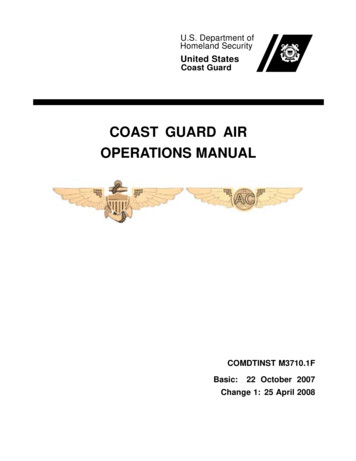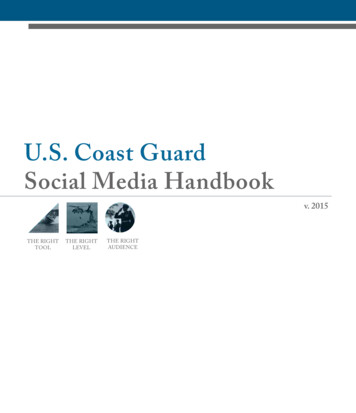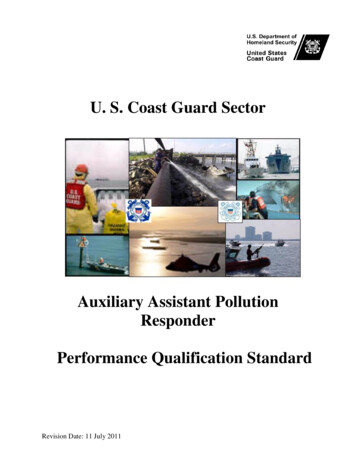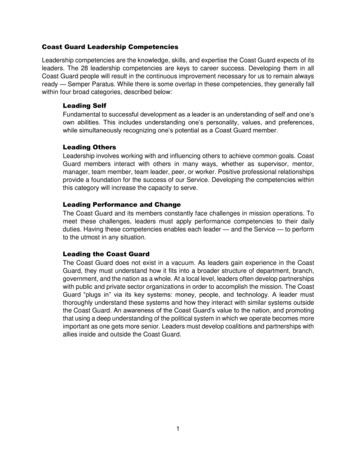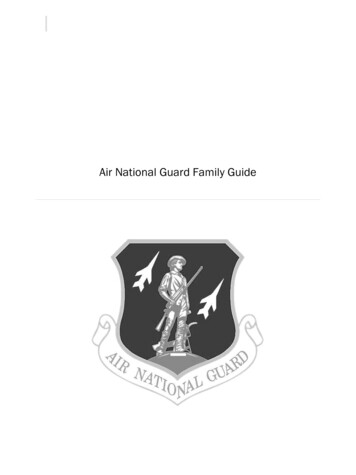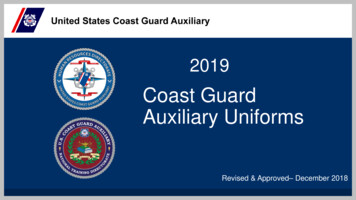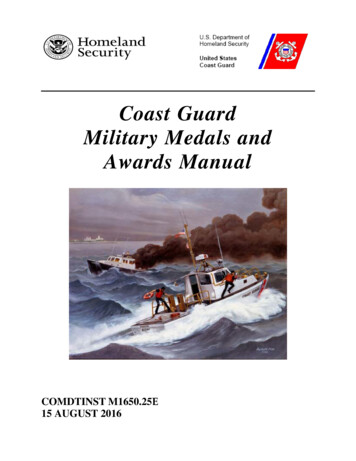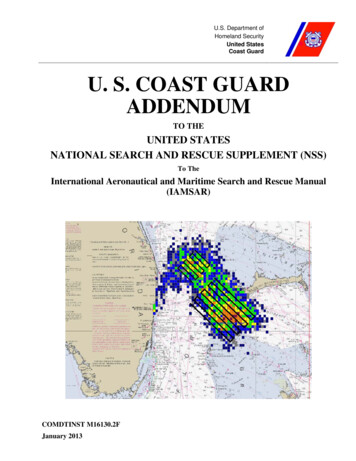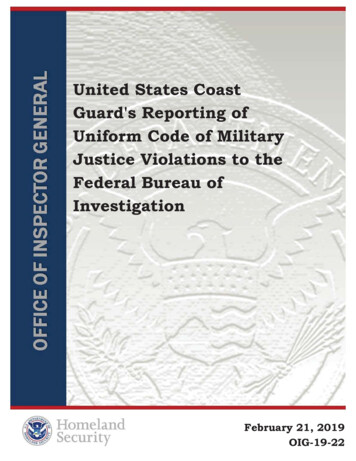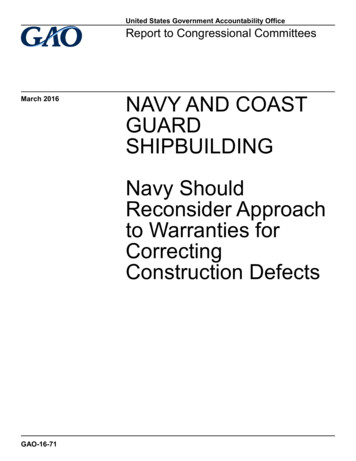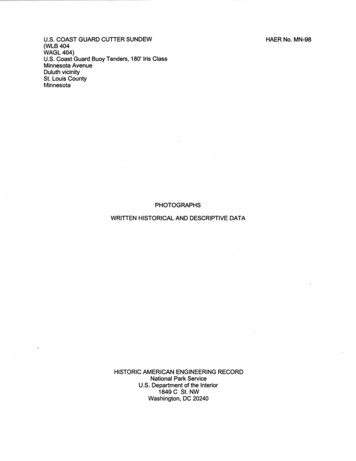
Transcription
U.S. COAST GUARD CUTIER SUNDEW{WLB404WAGL404)U.S. Coast Guard Buoy Tenders, 180' Iris ClassMinnesota AvenueDuluth vicinitySt. Louis CountyMinnesotaPHOTOGRAPHSWRITIEN HISTORICAL AND DESCRIPTIVE DATAHISTORIC AMERICAN ENGINEERING RECORDNational Park ServiceU.S. Department of the Interior1849 C St. NWWashington, DC 20240HAER No. MN-98
HISTORIC AMERICAN ENGINEERING RECORDU.S. COAST GUARD CUTTER SUNDEWHAER No. MN-98RIG/TYPEOF CRAFT:Cutter (Iris Class)TRADE:Buoy tending (government)OFFICIAL NUMBER:WLB-404 (WAGL-404)PRINCIPALDIMENSIONS:(As built)180'Length:Beam:37'Depth:12'Displacement: 935 tonsLOCATION:Sault St. Marie, MichiganDATES OFCONSTRUCTION:November 29, 1943 -August 24, 1944DESIGNER:Preliminary design by United States Coast Guard and final design byMarine Iron and Shipbuilding Corporation of Duluth, MinnesotaBUILDER:Marine Iron and Shipbuilding Corporation of Duluth, MinnesotaPRESENT OWNER:U.S. Coast GuardPRESENT USE:U.S. Coast Guard Cutter (Buoy tender)SIGNIFICANCE:This vessel was built to serve as a 180' U.S. Coast Guard cutter. Thefederal government purchased or built thirty-nine of these vessels, builtin three sub-classes, from 1942-1944. The U.S. Coast Guard(USCG) designed the 180s to service Aids-to-Navigation (AtoN),perform Search and Rescue missions (SAR), carry out LawEnforcement duties (LE), and conduct ice-breaking operations.Members of the class have served in the USCG from 1942 to thepresent. They have significantly contributed to safe navigation on inlandand international waters in times of peace and war.
U.S. COAST GUARD CUTTER SUNDEWHAER No. MN-98(Page 2)RESEARCHER:PROJECTINFORMATION:Marc Porter, 2002This project is part of the Historic American Engineering Record(HAER), a long-range program to document historically significantengineering and industrial works in the United States. The HAERprogram is administered by the Historic American BuildingsSurvey/Historic American Engineering Record Division (HABS/HAER)of the National Park Service, U.S. Department of the Interior, E. BlaineCliver, Chief.The U.S. Coast Guard Buoy Tenders, 180' Class Recording Projectwas sponsored by the U.S. Coast Guard, with Captain W. PatrickLane, Chief, Office of Civil Engineering; Kebby Kelly, EnvironmentalOfficer; and Dr. Robert Browning, Historian serving as liaisons. Theproject was prepared under the direction of HAER Maritime ProgramManager Todd Croteau. The historical report was produced by MarcPorter and edited by Justine Christianson, HAER Historian.FOR ADDITIONAL INFORMATION ON THE U.S. COAST GUARD BUOY TENDERS, 180'IRIS CLASS, SEE:HAER No. DC-57HAER No. DC-60HAER No. AK-45HAER No. AK-46HAER No. AK-47HAER No. AK-48HAER No. AL-199HAER No. CA-309HAER No. FL-17HAER No. GU-2HAER No. GU-3HAER No. HI-61HAER No. MA-152HAER No. ME-68HAER No. MI-323U.S. Coast Guard Buoy Tenders, 180' ClassU.S. Coast Guard Buoy Tenders, 180' Iris Class.U.S. Coast Guard Cutter FIREBUSHU.S. Coast Guard Cutter SEDGEU.S. Coast Guard Cutter SWEETBRIERU.S. Coast Guard Cutter WOODRUSHU.S. Coast Guard Cutter SALVIAU.S. Coast Guard Cutter BLACKHAWU.S. Coast Guard Cutter REDBUDU.S. Coast Guard Cutter SASSAFRASSU.S. Coast Guard Cutter BASSWOODU.S. Coast Guard Cutter MALLOWU.S. Coast Guard Cutter BITTERSWEETU.S. Coast Guard Cutter SPARU.S. Coast Guard Cutter BRAMBLE
U.S. COAST GUARD CUTTER SUNDEWHAER No. MN-98(Page 3)HAER No. MI-328HAER No. MN-98HAER No. NJ-139HAER No. OR-118HAER No. PR-43HAER No. TX-107HAER No. WA-169U.S.U.S.U.S.U.S.U.S.U.S.U.S.Coast Guard Cutter ACACIACoast Guard Cutter SUNDEWCoast Guard Cutter HORNBEAMCoast Guard Cutter IRISCoast Guard Cutter SAGEBRUSHCoast Guard Cutter BLACKTHORNCoast Guard Cutter MARIPOSA
U.S. COAST GUARD CUTTER SUNDEWHAER No. MN-98(Page 4)SUNDEW was the last of the 180s built by Marine Iron and Shipbuilding and the least expensive witha price tag of 861,589. SUNDEW's keel laying took place on November 29, 1943. The shipyardlaunched her on February 8, 1944, and the U.S. Coast Guard officially commissioned her on August24, 1944.SUNDEW spent the war years stationed in Wisconsin, first at Manitowoc and then at Milwaukee.Though far from the front lines, she played an important role in the war effort by marking safe shippinglanes and clearing them of ice to allow the products of America's industrial heartland to reach the Gulfof Mexico, the Atlantic Ocean, and eventually the fighting fronts.The tender's crew called Milwaukee home until 1953 when new orders transferred the cutter toSturgeon Bay, Wisconsin. SUNDEW operated out of Sturgeon Bay until June 1958 when shereceived a transfer to Charlevoix, Michigan. She remained there until August 1977 when she enteredthe Coast Guard yard at Curtis Bay, Maryland, for a "major renovation" that lasted one year.SUNDEW returned to Charlevoix after the yard period. Her homeport changed to Duluth, Minnesota;birthplace of the 180s, in 1980, and she continues to operate out of that port through the present.SUNDEW's homeport has changed a number of times but her duties have not. She has servedprimarily as an AtoN tender during summer and fall months. During the winter and spring, she breaksice to clear shipping lanes and free trapped vessels. When vessels find themselves in need of assistanceon the Great Lakes and call the Coast Guard, the local SAR coordinator dispatches SUNDEW to helpif she .is in range of the distressed craft.In recent years her duties have expanded to encompass some scientific research responsibilities. Shenow aids scientists in tracking the spread of Zebra Mussels in Lake Superior. She also helps procurewater and bottom samples for scientists studying the Great Lakes. Besides helping the NationalOceanographic and Atmospheric Administration (NOAA) deploy and maintain weather buoys,SUNDEW sometimes serves as a floating weather station and feeds data to the National WeatherService. 1SUNDEW has been a Great Lakes vessel for virtually her entire career. The single exception, besidesthe trip to and from Curtis Bay, was a LE patrol in the Caribbean during the winter of 1987-1988.Outwardly, SUNDEW appears little changed from the day she left the Marine Iron and Shipbuildingyard. There have, however, been significant changes required to keep the tender on active duty for1 Wes Hall, Historical Context and Statement ofSignificance: Cactus, Mesquite, and Basswood Classes,United States Coast Guard 180-foot Buoy Tenders (WLBs) (Castle Hayne, North Carolina: Mid-Atlantic Technologyand Environmental Research, 1997), 23.
U.S. COAST GUARD CUTTER SUNDEWHAER No. MN-98(Page 5)such a long period. During the yard period at Curtis Bay a new hydraulic boom replaced SUNDEW'sold electric cargo handling gear. At the same time, a bow thruster was installed to give the single screwvessel more maneuverability. The needs and comfort of the crew were also addressed during theoverhaul when shipyard workers installed air conditioning on the tender. Seven years after the majorrenovation program overhaul SUNDEW entered a shipyard for another one. This time, mechanicsinstalled new diesels to generate power for her electric motor. 2As of January 2002 SUNDEW remains on active duty, serving on the Great Lakes. The U.S. CoastGuard has tentatively set her decommissioning date as sometime no later than June 2004. 32Hall, 8.3 Hall,8.
ADDENDUM TO:U.S. COAST GUARD CUTTER SUNDEW(WLB 404WAGL 404)U.S. Coast Guard Buoy Tenders, 180' Iris ClassMinnesota AvenueDuluth vicinitySt. Louis CountyMinnesotaPAPER COPIES OF COLOR TRANSPARENCIESHISTORIC AMERICAN ENGINEERING RECORDNational Park ServiceU.S. Department of the Interior1849 C St. NWWashington, DC 20240HAER No. MN-98
lanes and clearing them of ice to allow the products of America's industrial heartland to reach the Gulf of Mexico, the Atlantic Ocean, and eventually the fighting fronts. The tender's crew called Milwaukee home until 1953 when new orders transferred the cutter to Sturgeon Bay, Wisconsin. SUNDEW operated out of Sturgeon Bay until June 1958 when she
